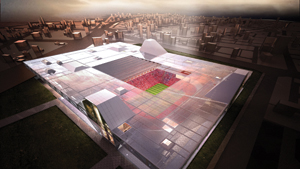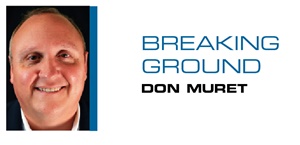The
Sports City stadium proposed for Qatar could be the most expensive sports facility ever built now that FIFA plans to play a 2022 World Cup semifinal there, according to
Dan Meis, the project’s designer.
The stadium’s original design covered 45,000 seats with a construction cost of $1.6 billion. Now that Sports City is expected to be among the World Cup’s primary venues, the project will be expanded to 65,000 seats.
 |
POPULOUS
The Sports City stadium is planned as a “full entertainment destination in one building.” |
The final cost will not be known until Meis, a senior principal at
Populous, completes a more detailed design, but in the end it could “creep up to $2 billion and change,” he said.
“A lot of the cost is the fact that it’s much more than a stadium,” Meis said. “That’s kind of the big idea, that it’s a full entertainment destination in one building. It’s a mall, it includes a hotel tower, an office tower and a media tower that all support this giant floating roof and there’s occupied space up on the roof, as well. There are places where you can look from the roof of the building down to the pitch or to the plaza.”
Typically, in a hot climate such as Qatar, a stadium would be built with a dome, and for World Cup, the surrounding development would be built outside the facility. Sports City takes that development and puts it all under one protective roof, Meis said.
The stadium would also be one of the world’s most technologically advanced sports facilities, with removable seats that can scale the building down to a 10,000-seat amphitheater.
In that respect, the Sports City project resembles Saitama Super Arena in Japan, a stadium that can shrink in size from 37,000 seats to 12,500 for an end-stage concert, which Meis designed earlier in his career.
RUSTED ROOT: Since May, the prototype for the Barclays Center facade has been gathering rust down the street from the arena construction site in Brooklyn.
Outside of arena developer Forest City Ratner’s project office, a mock-up with 12 rusted steel panels represents the arena’s exterior look.
When the arena opens in September 2012, about 130,000 square feet of the facade will have the same rusted appearance, said Bob Sanna, Barclays Center’s director of design and construction.
Thousands of panels are undergoing extensive weathering at a plant owned by ASI Limited, an exterior wall manufacturer based near Indianapolis. Over four to five months, those panels are being wet and dried 1,100 times to achieve the rusty look. Using rainwater collected from the factory’s roof, ASI officials are accelerating a process that would ordinarily take nine years under natural weather conditions, Sanna said.
“It looks like a dry cleaning line,” he said. “Each panel goes through a station that spritzes it, then it moves ahead with heat lamps that dries it. The intent is to get this warm, weathered look.”
SHoP Architects, the New York City design firm teaming with Aecom to design Barclays Center, came up with the rusty exterior idea.
BRITISH STEEL: Tom Tingle’s ties to the sports industry have helped British firm Intelligent Engineering sign its first two seating structure deals in the United States: the USTA Billie Jean King National Tennis Center and Georgia Tech’s arena renovation.
Tingle, a sports architect by trade, is vice president in charge of business development for Intelligent Engineering, a position he has held for the last year. The company builds lightweight seating bowl products with polyurethane wedged between two layers of steel.
At the National Tennis Center, Intelligent Engineering has teamed with Southern Bleacher Co. to build a seating structure for a new 2,500-seat outdoor facility in the complex’s southeast corner. In Atlanta, Intelligent Engineering is building the 2,000-seat upper bowl as part of a $45 million face lift of Alexander Memorial Coliseum.
The company expects to deliver its finished products in October, Tingle said.
Don Muret can be reached at dmuret@sportsbusinessjournal.com. Follow him on Twitter @BreakGround.





